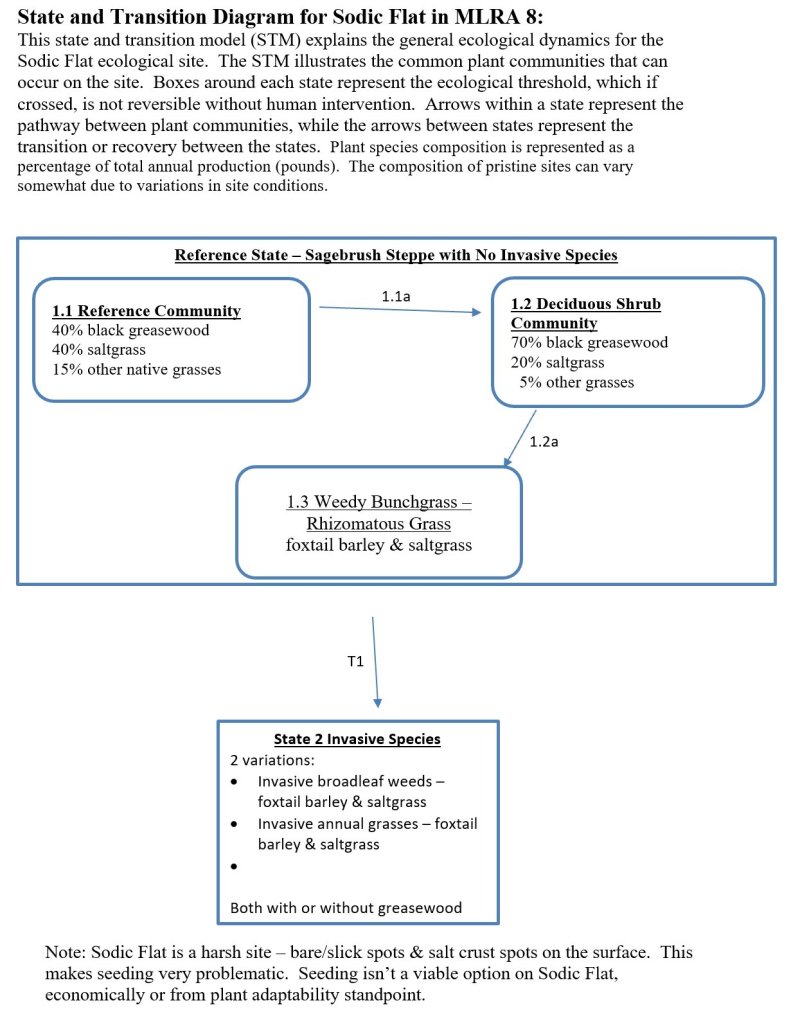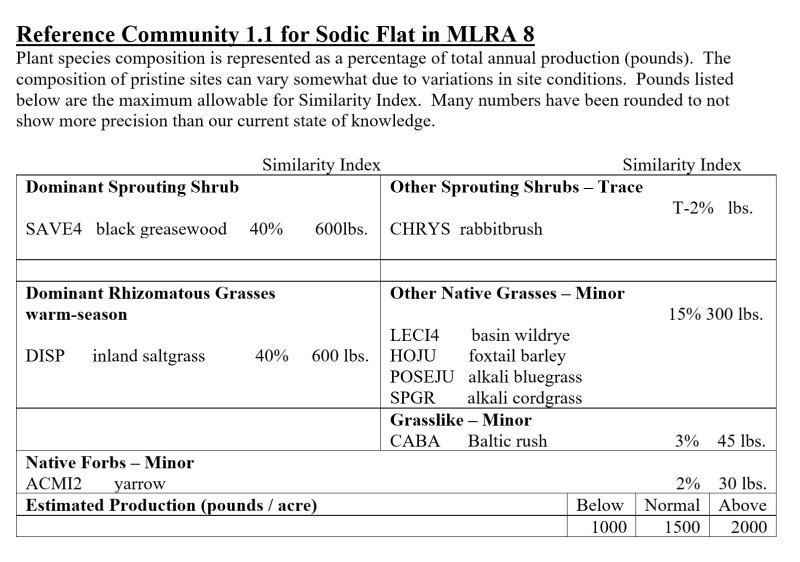Ecological site group R008XG978WA
Sodic Flat
Last updated: 09/21/2023
Accessed: 12/21/2025
Ecological site group description
Key Characteristics
None specified
Provisional. A provisional ecological site description has undergone quality control and quality assurance review. It contains a working state and transition model and enough information to identify the ecological site.
Physiography
Hierarchical Classification
Major Land Resource Area (MLRA): 8 – Columbia Plateau
LRU – Common Resource Areas (CRA):
8.1 - Channeled Scablands
8.2 - Loess Islands
8.3 - Okanogan Drift Hills
8.4 - Moist Pleistocene Lake Basins
8.5 - Moist Yakima Folds
8.6 - Lower Snake and Clearwater Canyons
8.7 - Okanogan Valley
Site Concept Narrative:
In the upland setting ecological sites are often expansive, and thus, can be delineated and separated on aerial photos. But in the landscape position of bottoms, basins and depressions this is rarely the case as small changes in soil chemistry, the water table and elevation or aspect results in significant changes in plant community composition. In short distances there are often big swings of available water holding capacity, and soils can go from hydric to non-hydric, or from saline-sodic to not. So, in bottoms, riparian areas and depressions, ecological sites and community phases occur as small spots, strips and patches, or as narrow rings around vernal ponds. And generally, in a matter of steps one can walk across several ecological sites. On any given site location, two or more of these sites occur as a patchwork – Loamy Bottom, Alkali Terrace, Sodic Flat, Wet Meadow, Herbaceous Wetland and Riparian Woodland. These ecological sites may need to be mapped as a complex when doing resource inventory.
Diagnostics:
Sodic Flat has a two-layered plant community. The top layer is scattered or patchy black greasewood, which is a 3-6 feet tall deciduous shrub with spines and fleshy leaves. The bottom layer, saltgrass, is a short, warm season rhizomatous grass. At the soil surface Sodic Flat is a patchy network of bare ground and saltgrass as there is no moss or lichens.
Sodic Flat is part of the lentic (standing water) ecosystem. It occurs on valley flats, bottoms, basins, terraces and depressions. This site may also occur as a narrow zonal ring around ponds and vernal pools. Soils are typically deep, clay loam and silt loam texture and have limited rock fragments (generally 10% or less) in the root-growing portions of the soil profile. Soils are hydric and strongly to very strongly alkaline.
Sodic Flat is a harsh site. Not many plant species can tolerate the sodic conditions.
Principle Vegetative Drivers:
An elevated water table and very strongly alkaline-sodic soil chemistry drive the vegetative expression of the Sodic Flat ecological site. A limited number of plant species are adapted to the high pH. Conditions are so harsh that 40-80% of the soil surface is bare. Saltgrass is spotty and greasewood is scattered or patchy across the site.
Influencing Water Features:
Sodic Flat soils are poorly drained to moderately well drained and have mostly slow permeability. So, there are significant restrictions with water infiltrating into the soil, and thus, the soils remain saturated and in an anaerobic condition from late winter to mid-spring. By late summer Sodic Flat is dry.
Physiographic Features:
The landscape is part of the Columbia basalt plateau. Sodic Flat occurs on valley flats, bottoms, basins, terraces and depressions. This site may also occur as a narrow zonal ring around ponds and vernal pools. So, in bottoms, riparian areas and depressions, ecological sites and community phases occur as small spots, strips and patches, or as narrow rings around vernal ponds. Generally, in a matter of steps one can walk across several ecological sites. On any given site location, two or more of these sites occur as a patchwork – Loamy Bottom, Alkali Terrace, Sodic Flat, Wet Meadow, Herbaceous Wetland and Riparian Complex. These ecological sites may need to be mapped as a complex when doing resource inventory.
Physiographic Division: Intermontane Plateau
Physiographic Province: Columbia Plateau
Physiographic Sections: Walla Walla Plateau Section
Landscapes: Hills and plateaus
Landform: Drainageways, depressions and terraces
Elevation: Dominantly 1,000 to 3,600 feet
Slope: Total range: 0 to 15 percent
Central tendency: 0 to 5 percent
Aspect: Occurs on all aspects
Geology:
This MLRA is almost entirely underlain by Miocene basalt flows. Columbia River basalt is covered in many areas with as much as 200 feet of loess and volcanic ash. Small areas of sandstones, siltstones, and conglomerates of the Upper Tertiary Ellensburg Formation are along the western edge of this area. Some Quaternary glacial drift covers the northern edge of the basalt flows, and some Miocene-Pliocene continental sedimentary deposits occur south of the Columbia River, in Oregon.
A wide expanse of scablands in the eastern portion of this MLRA, in Washington, was deeply dissected about 16,000 years ago, when an ice dam that formed ancient glacial Lake Missoula was breached several times, creating catastrophic floods. The geology of the northernmost part of this MLRA is distinctly different from that of the rest of the area. Alluvium, glacial outwash, and glacial drift fill the valley floor of the Okanogan River and the side valleys of tributary streams. The fault parallel with the valley separates pre-Tertiary metamorphic rocks on the west, in the Cascades, from older, pre-Cretaceous metamorphic rocks on the east, in the Northern Rocky Mountains. Mesozoic and Paleozoic sedimentary rocks cover the metamorphic rocks for most of the length of the valley on the west.
Climate
The climate is characterized by moderately cold, wet winters, and hot, dry summers, with limited precipitation due to the rain shadow effect of the Cascades. Taxonomic soil climate is either xeric (12 – 16 inches PPT) or aridic moisture regimes (10 – 12 inches PPT) with a mesic temperature regime.
Mean Annual Precipitation:
Range: 10 – 16 inches
Seventy to seventy-five percent of the precipitation comes late October through March as a mixture of rain and snow. June through early October is mostly dry.
Mean Annual Air Temperature:
Range: 44 to 54 F
Central Tendency: 48 – 52 F
Freezing temperatures generally occur from late-October through early-April. Temperature extremes are 0 degrees in winter and 110 degrees in summer. Winter fog is variable and often quite localized, as the fog settles on some areas but not others.
Frost-free Period (days):
Total range: 90 to 200
Central tendency: 110 to 160
The growing season for Sodic Flat is March through end of July.
Soil features
Edaphic:
Soils are deep, silt loam, silty clay loam or sandy loam formed in glaciolacustrine or glaciofluvial, or alluvium. Sodic Flat commonly occurs adjacent to Alkali Terrace, Loamy Bottom, Riparian Woodland, and Herbaceous Wetland ecological sites. Sodic Flat also occurs with upland sites such as Loamy, Stony and Cool Loamy.
Representative Soil Features:
This ecological site components are dominantly Typic and Duric taxonomic subgroups of Halaquepts and Natrixerolls great groups of the Mollisols and Inceptisols taxonomic order. Soils are moderately deep to very deep. Average available water capacity of about 5.5 inches (14.0 cm) in the 0 to 40 inches (0-100 cm) depth range.
Soil parent material is dominantly mixed alluvium.
The associated soils are Emdent, Halaquepts, Spofford, Umapine, Weissenfels and similar soils.
Dominate soil surface is silt loam to very fine sandy loam, with ashy modifier sometimes occurring as well.
Dominant particle-size class is fine to coarse-loamy.
Fragments on surface horizon > 3 inches (% Volume):
Minimum: 0
Maximum: 5
Fragments within surface horizon > 3 inches (% Volume):
Minimum: 0
Maximum: 5
Average: 1
Fragments within surface horizon ≤ 3 inches (% Volume):
Minimum: 0
Maximum: 5
Average: 2
Subsurface fragments > 3 inches (% Volume):
Minimum: 0
Maximum: 10
Average: 4
Subsurface fragments ≤ 3 inches (% Volume):
Minimum: 0
Maximum: 15
Average: 5
Drainage Class: Range from poorly drained to somewhat well drained.
Water table depth: 5 to greater than 40 inches
Flooding:
Frequency: None to rare
Ponding:
Frequency: None to frequent
Saturated Hydraulic Conductivity Class:
0 to 10 inches: Moderately high
10 to 40 inches: Moderately high
Depth to root-restricting feature (inches):
Minimum: 20
Maximum: greater than 60
Electrical Conductivity (dS/m):
Minimum: 0
Maximum: 10
Sodium Absorption Ratio:
Minimum: 15
Maximum: 30
Calcium Carbonate Equivalent (percent):
Minimum: 0
Maximum: 20
Soil Reaction (pH) (1:1 Water):
0 - 10 inches: 6.6 to 11
10 - 40 inches: 7.4 to 11
Available Water Capacity (inches, 0 – 40 inches depth):
Minimum: 4.0
Maximum: 8.3
Average: 5.5
Vegetation dynamics
Ecological Dynamics:
Sodic Flat produces about 1500 pounds/acre of biomass annually.
Regarding saline-alkali soils Daubenmire (page 50) wrote, “It seems impossible to find areas where one can be confident that the vegetation has not been somewhat altered by domesticated animals.” Some areas were also manipulated by tillage or other farming practices.
Black greasewood is a spiny, deciduous, semi-evergreen shrub that grows 3-10 feet tall. It has high tolerance to sodic and saline affected soils. Greasewood is highly drought tolerant but can also tolerate a high, water table.
Generally, greasewood receives limited grazing from livestock. Greasewood plants contain sodium and potassium oxalates, and are toxic to livestock, but can be safely grazed in light amounts in the spring while the leaves ae growing. This shrub sprouts readily following a fire. Greasewood can tap into groundwater at a great depth.
Greasewood and saltgrass have greater tolerance of high salinity, high water table and pH than does basin wildrye. So, basin wildrye has limited adaptation to Sodic Flat.
Saltgrass is a short, warm-season, sod-forming grass that can form dense mats with rhizomes and sometimes stolons. Saltgrass is one of the most common plants found on saline-alkaline soils and it is one of the most drought tolerant species. Being rhizomatous, saltgrass is tolerant of moderate to heavy grazing, and as a warm-season grass, it provides green forage a little longer than adjacent upland sites.
Among plants there is a decreasing tolerance of high-water table and high salinity:
Winterfat spiny hopsage rabbitbrush big sagebrush
Saltgrass alkaligrass spike-rush basin wildrye western wheatgrass
Fire and grazing are two of the main disturbances to the rangeland of Eastern Washington. Fire has minimal effect on Sodic Flat sites. Saltgrass is rhizomatous with growing points protected below ground, while greasewood readily sprouts when burned. Under heavy grazing pressure the amount of bare ground will increase and over time invasive species colonize.
In Washington, greasewood-saltgrass communities provide habitat for a variety of upland wildlife species.
Supporting Information:
Associated Sites:
Sodic Flat is associated with other ecological sites in bottoms and basin areas of MLRA 8, including Alkali Terrace, Loamy Bottom, Wet Meadow, Wetland Complex and Riparian Complex. Alkali Terrace is also associated with upland sites such as Loamy, Stony, Very Shallow and Cool Loamy.
Similar Sites:
MLRA 7 Columbia Basin has a comparable Sodic Flat ecological site.
Inventory Data References (narrative):
Data to populate Reference Community came from several sources: (1) NRCS ecological sites from 2004, (2) Soil Conservation Service range sites from 1980s and 1990s, (3) Daubenmire’s habitat types, and (4) ecological systems from Natural Heritage Program
Major Land Resource Area
MLRA 008X
Columbia Plateau
Subclasses
Stage
Provisional
Contributors
Provisional Site Author: Kevin Guinn
Technical Team: K. Moseley, G. Fults, R. Fleenor, W. Keller, K. Bomberger, C. Gaines, K. Paup-Lefferts
Click on box and path labels to scroll to the respective text.

